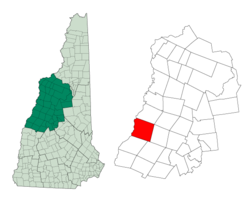Lyme, New Hampshire
| Lyme, New Hampshire | |
|---|---|
| Town | |
 Location in Grafton County, New Hampshire |
|
| Coordinates: 43°48′37″N 72°09′22″W / 43.81028°N 72.15611°WCoordinates: 43°48′37″N 72°09′22″W / 43.81028°N 72.15611°W | |
| Country | United States |
| State | New Hampshire |
| County | Grafton |
| Incorporated | 1761 |
| Government | |
| • Board of Selectmen | Susan J. MacKenzie, Chair Patricia G. Jenks Charles J. Smith |
| Area | |
| • Total | 54.7 sq mi (141.7 km2) |
| • Land | 53.8 sq mi (139.4 km2) |
| • Water | 0.9 sq mi (2.3 km2) 1.62% |
| Elevation | 548 ft (167 m) |
| Population (2010) | |
| • Total | 1,716 |
| • Estimate (2015) | 1,680 |
| • Density | 31/sq mi (12.0/km2) |
| Time zone | Eastern (UTC-5) |
| • Summer (DST) | Eastern (UTC-4) |
| ZIP code | 03768, 03769 |
| Area code(s) | 603 |
| FIPS code | 33-44260 |
| GNIS feature ID | 0873654 |
| Website | www |
Lyme is a town along the Connecticut River in Grafton County, New Hampshire, United States. The population was 1,716 as of the 2010 census, with an estimated population of 1,680 in 2015. Lyme is home to the Chaffee Natural Conservation Area. The Dartmouth Skiway is in the eastern part of town, near the village of Lyme Center. The Appalachian Trail passes through the town's heavily wooded eastern end.
This was once a home to Abenaki Indians, including a band of Sokokis near Post Pond at a place they called Ordanakis. Later, it would be another of many towns granted by Colonial Governor Benning Wentworth along the Connecticut River in 1761. Many of the 63 grantees lived in Massachusetts and Connecticut, but virtually none of them ever settled in Lyme; they sold or assigned their grants to others. However, those settlers who did arrive in 1764 were mostly from those states. In the late 1770s, the town petitioned (ultimately unsuccessfully) to join Vermont.
The scenic town common is surrounded with houses and public buildings dating from the late 1700s to the early 1900s. Stagecoaches traveling the old "Boston Turnpike" from Montreal in the 1830s passed through Lyme, stopping at the Lyme Inn (recently renovated), built in 1809. Next door to the inn is the 200-year-old Congregational Church. Its original 1815 steeple bell was cast by Paul Revere. It was later replaced with a bell cast by Henry N. Cooper & Co., Boston. A hand-wound clock mechanism from E. Howard & Co. strikes the hour. Behind the church is a row of horse sheds dating from 1810 - the longest surviving row of horse sheds in New England. Originally each shed had the name of the owner on a sign above the door. The signs are still there, though not necessarily over the original shed.
...
Wikipedia
